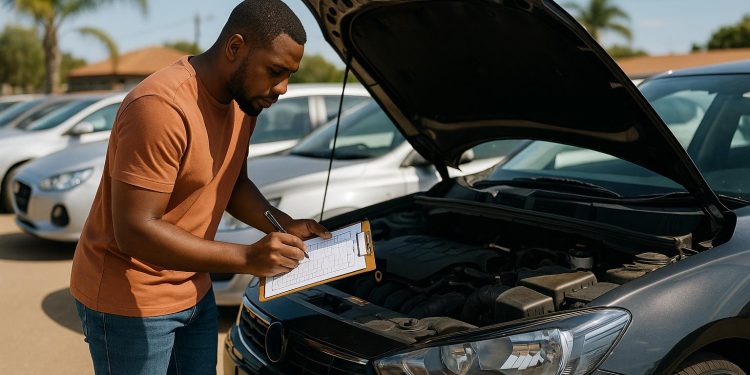Buying a used car can save you money, but skipping an inspection could cost you thousands in repairs or legal issues. Here’s a quick checklist to ensure a smooth purchase:
- Verify Ownership: Check the Vehicle Registration Certificate. Confirm the VIN and engine number match the car. Ensure the seller has legal authority to sell, especially if the car is financed.
- Roadworthy Certificate: Required for ownership transfer. It’s valid for 60 days and costs $30–$50. If the seller doesn’t provide it, you’ll need to handle this.
- Service History: Look for complete maintenance records. Missing or incomplete history could signal hidden issues.
- Physical Inspection: Check for rust, dents, misaligned panels, tire wear, and interior condition. Inspect under the hood for leaks, worn belts, and battery health.
- Test Drive: Evaluate acceleration, braking, steering, suspension, and overall comfort. Listen for unusual noises and ensure all electronics work.
- Fluid Levels: Inspect engine oil, coolant, brake fluid, and transmission fluid for proper levels and quality.
Spending $100–$200 on a pre-purchase inspection can prevent unexpected repair costs ranging from $1,500 to $5,000. Always trust your instincts and walk away if something feels off.
HOW TO INSPECT A CAR | Important Checklist Before Buying! 🔍
Documentation and Legal Checks
Before handing over your money, make sure the seller legally owns the vehicle. Skipping this step could leave you with a car you can’t legally drive or register in your name.
Check the Vehicle Registration Certificate
The Certificate of Registration in Respect of Motor Vehicle is the key document proving the seller owns the car. Issued by Natis, this certificate must correspond to the actual vehicle you’re buying.
Start by confirming that the Vehicle Identification Number (VIN) on the certificate matches the VIN on the car’s body or chassis. Any discrepancy between the two is a major red flag. If the VIN isn’t recognized in the Natis system, walk away. The VIN is cross-checked during multiple stages of ownership, and mismatches can cause serious legal problems.
Next, ensure the engine number listed on the certificate matches the one stamped on the engine block. If they don’t align, you’ll need to verify the engine’s origin, which could involve additional clearances and paperwork. This could delay your purchase and create unnecessary complications.
Also, check the Title Holder details. If the car is still under financing, the finance company will be listed as the titleholder. In this case, the seller must have authorization to sell the car. Keep in mind that while the seller may be listed as the "Owner" (responsible for traffic fines and licensing), they cannot sell the vehicle legally without the titleholder’s approval.
Confirm the Roadworthy Certificate
Once you’ve verified ownership, the next step is ensuring the car meets safety standards. A valid roadworthy certificate is required to transfer ownership. This document confirms the car complies with safety requirements under the Road Traffic Act. Without it, the licensing department won’t process the ownership change.
The certificate is valid for 60 days, so if it’s close to expiring, you’ll need to act quickly to complete the transfer. A roadworthy test typically costs between $30 and $50.
Double-check that the certificate is in the seller’s name and applies specifically to the vehicle you’re buying. Some sellers might attempt to use an older certificate or one issued for a different car. The certificate must list the exact VIN and registration details of the car you’re purchasing.
If the seller is offering the car "as is" without a roadworthy certificate, understand that you’ll be responsible for getting one yourself. This means factoring in the cost of the test and potential repair expenses, as the car might require fixes to pass inspection.
Review Service History and License Status
The service history is a goldmine of information about the car’s maintenance and repairs. Vehicles with a full service history and documented maintenance tend to hold higher value than those with an unclear background. These records can also boost the car’s resale value in the future.
Look for receipts showing routine maintenance like oil changes, tire rotations, and manufacturer-recommended services. Each receipt should include the odometer reading, which helps verify the car’s mileage. If the service records are incomplete or unverifiable, proceed with caution, as this could signal hidden issues.
Check whether the car has followed the manufacturer’s recommended maintenance schedule. Skipping major services can lead to mechanical problems that might not show up immediately. Detailed service records also come in handy for warranty claims or insurance disputes if issues arise after your purchase.
Finally, ensure the car’s license is up to date. An expired license adds extra costs and delays to the transfer process. Ideally, the seller should renew the license before the sale. If they haven’t, negotiate who will cover this expense before finalizing the deal.
Physical Inspection: Outside and Inside the Car
Once the paperwork checks out, it’s time to dive into the car’s physical condition. A thorough inspection helps you spot signs of neglect or hidden issues that might not show up in the service records. This step ensures you’re making a smart purchase.
Check the Outside for Damage
Start by examining the car in natural daylight. This makes it easier to catch paint inconsistencies or bodywork flaws that could go unnoticed under artificial lighting. Go over every panel carefully.
Keep an eye out for dents, scratches, or rust spots. While minor scratches are common, deep gouges or widespread rust might indicate poor upkeep or past accidents. Pay extra attention to areas prone to rust, such as wheel wells, door frames, and the lower edges of doors.
Look closely for uneven paint or overspray around seals, as these can hint at post-accident repairs. Check the alignment of panels and gaps around doors, the hood, and the trunk. Misaligned panels or uneven gaps could point to frame damage or subpar repair work.
Don’t skip the undercarriage – use a flashlight to check for rust, corrosion, or welding marks, which might signal structural damage. Lastly, inspect the windows and windshield for chips or cracks. Even a small chip can spread over time and lead to costly repairs.
Once you’ve assessed the exterior, shift your attention to the tires and their alignment.
Check Tire Condition and Wheel Alignment
Tires can tell a story about how well the car’s been maintained. Use a penny to check the tread depth: if Lincoln’s head is fully visible, the tire needs replacing.
Look for uneven wear patterns, as these can reveal alignment or suspension problems. For example, a saw-tooth pattern on the front tires might indicate a toe alignment issue, while excessive wear on the inner or outer edges could suggest camber problems.
Next, use a tire pressure gauge to ensure each tire is inflated to the manufacturer’s recommended level, which you’ll find on the driver’s door placard. Uneven or low pressure in one or more tires might signal slow leaks or neglect. Inspect for any cuts, punctures, sidewall cracks, or bulges – bulges, in particular, can mean internal damage that risks sudden failure.
After confirming the tires are in good shape, move on to the interior.
Check the Interior and Features
Step inside and pay attention to any unusual smells. A musty odor could be a sign of water damage, which may lead to bigger issues down the line.
Test all electronics, including the climate controls, audio system, and windows, to ensure everything works properly. Inspect the seats, pedals, and floor mats for wear and tear. When examining the pedals, compare their condition to the car’s mileage – excessive wear on a low-mileage car might raise questions about the odometer’s accuracy.
"Knowing how to spot potential problems and determining reliability can save you from expensive automotive headaches down the road."
– Jon Linkov, Autos Editor, Consumer Reports
Don’t forget to check the trunk. Look for signs of water damage, such as moisture around the spare tire well, and confirm that the spare tire and tools are present. Test the seatbelts by pulling them out fully to ensure they retract smoothly, and check that the buckles secure and release without issue. Faulty seatbelts can compromise safety, so don’t overlook this step.
sbb-itb-09752ea
Engine and Mechanical Checks
Once the interior is sorted, it’s time to turn your attention to the engine and mechanical systems. A thorough inspection under the hood can tell you a lot about how well the car has been maintained and might even help you spot potential problems before they become your headache.
Look Under the Hood
Pop the hood and take a good look around before diving into specific components. A clean engine bay can indicate regular upkeep, while excessive dirt or grime might suggest neglect.
Start by checking the rubber hoses and belts. Healthy hoses should feel firm yet flexible – any cracks, bulges, or soft spots could mean trouble down the line. Similarly, drive belts should be free of fraying or cracks, as worn belts are prone to snapping without warning.
Next, inspect the battery terminals for any buildup of white or green corrosion. Excessive corrosion can interfere with electrical connections and might hint at a struggling battery. If the battery has removable caps, peek inside to ensure the fluid covers the internal plates. Also, look for any fresh oil spots, coolant stains, or puddles that might signal leaks near the oil pan, transmission, or radiator.
Don’t forget the air filter. Locate its housing and check its condition – a clean filter is essential for optimal engine performance, while a clogged one can hinder it.
"Most dealerships clean the engine compartment, but you may find the fluid is low in a particular system." – Nicole Miskelley, PMR Auto & Diesel Repair manager
Test Engine Performance and Exhaust Smoke
Fire up the engine and pay attention to how it behaves, especially during a cold start, as this can reveal issues that might not show up once the engine warms.
Listen closely. The engine should idle smoothly without any knocking, ticking, rattling, or hissing sounds. Knocking or ticking could indicate internal engine problems, while hissing might point to a vacuum leak.
Take a look at the exhaust smoke. Light gray-white smoke with a typical fuel smell is normal. However, blue, dark gray, or black smoke suggests the engine is burning oil, and persistent white smoke might mean coolant is leaking into the combustion chambers.
As the engine idles, watch for steady RPMs without excessive vibrations, shaking, or stalling. Also, check the check engine light – it should briefly light up when you turn the key and then go off once the engine starts. If it stays on or doesn’t light up at all, there could be an issue with the engine or its warning system.
Check Fluid Levels and Quality
Fluids are like the lifeblood of a car, and their condition can reveal a lot about its maintenance history. Here’s what to look for:
- Engine Oil: Pull the dipstick and check the oil level. The oil should fall between the marks and appear yellow or amber with a smooth texture. Milky or foamy oil might indicate a coolant leak.
- Transmission Fluid: Check this while the engine is running and warm. It should be pink or red with a normal oil smell. Brown or burnt-smelling fluid could mean trouble with the transmission.
- Brake Fluid: This should be clear and sit between the "min" and "max" lines on the reservoir. Dark or cloudy fluid might suggest moisture contamination or overdue servicing.
- Coolant: When the engine is cool, inspect the coolant reservoir. The fluid should be greenish or orange and sit between the indicated levels. Milky or rusty coolant could point to issues like a blown head gasket.
- Power Steering Fluid: Make sure the fluid level in its reservoir is adequate. Low levels might indicate leaks in the power steering system.
Test Drive and Practical Checks
When you’re considering a car, the test drive is your chance to see how it performs in real-world conditions and decide if it aligns with your needs.
Test Driving Performance
Drive the car in a variety of settings – city streets, highways, hills, and even rougher roads. Each environment highlights different aspects of the car’s handling and performance.
Pay attention to how the car accelerates. Does it respond smoothly when you press the gas pedal? Test its performance both from a complete stop and when merging into traffic. If the engine hesitates or feels sluggish, it could signal issues like fuel system problems or engine wear.
Next, evaluate the brakes. Gradually apply pressure at different speeds to check for smooth stopping. The car should not pull to one side, and the brake pedal shouldn’t pulsate. Be on the lookout for squealing or grinding noises – these often point to worn brake pads or rotors. While driving, the steering wheel should feel firm and responsive, with no excessive play or vibrations, and the car should maintain a straight path without drifting.
For transmission checks, manual gear shifts should be smooth without grinding, and automatic transmissions should change gears seamlessly without hesitation or slipping.
Drive over uneven roads or speed bumps to assess the suspension. A properly functioning suspension should absorb impacts without excessive bouncing or knocking, which could indicate worn-out shocks or other suspension issues.
Finally, turn off the radio during the drive to listen for any unusual noises from the engine or road that might otherwise go unnoticed.
Once you’ve assessed the performance, shift your focus to the car’s comfort and usability.
Check Comfort and Ease of Use
Start by adjusting the driver’s seat and mirrors. You should be able to find a comfortable driving position with good support, and all controls should be within easy reach – no awkward stretching or straining required.
Take a close look at the dashboard and controls. Test every button, knob, and switch to ensure they work as intended, especially for essentials like air conditioning, heating, and the infotainment system. Think about the cabin’s layout: Can you easily access the gear shifter, handbrake, and other commonly used controls? Poor design can make long drives uncomfortable or even compromise safety.
If possible, bring along a friend or family member to evaluate passenger comfort and space. Their feedback can help confirm whether the car meets the needs of everyone who might ride in it regularly.
Now, move on to checking the car’s practical features.
Test Practical Features
Start with the climate control system. Both the air conditioning and heating should work effectively – reliable climate control is crucial, especially if you live in a region with varying weather conditions.
Next, test the car’s connectivity options. Check USB ports, power outlets, Bluetooth functionality, and, if available, Apple CarPlay or Android Auto. Make sure the windows roll up and down smoothly and quietly. If the car has a navigation system, test it along with the infotainment controls. Simple tasks like adjusting the radio or changing the temperature should feel intuitive.
Don’t overlook convenience features like the electric trunk or rear liftgate. If the car is equipped with safety features such as automatic emergency braking, blind spot monitoring, or rear cross-traffic alerts, ask the seller to demonstrate them or explain how they work.
Finally, inspect the dashboard instruments. When you start the car, all warning lights should briefly illuminate and then turn off. Any lights that stay on might signal underlying problems.
Take your time with this process. The test drive is your chance to go beyond imagining ownership and truly experience what it would be like to have this car as part of your daily life.
Conclusion: Making a Smart Purchase Decision
When it comes to buying a used car, taking your time and conducting thorough research can save you from costly mistakes. With over 8 million used cars sold annually in South Africa, the market offers a wide range of options. But with so many choices, it’s essential to stay vigilant and make informed decisions to find the right vehicle.
Following the steps in our comprehensive checklist can make all the difference. Carefully review all documentation, perform a detailed inspection of the car’s interior and exterior, assess its mechanical condition, and take it for a test drive in different driving scenarios.
"If you are buying a second hand car, you’d be wise to use the checklist below to help you assess the car in the best way possible to ultimately make the best buying decision!"
– Gero Lilleike, Cars.co.za
Spending $100–$200 on a pre-purchase inspection might seem like an extra expense, but it can uncover hidden issues that could otherwise result in repair costs ranging from $1,500 to $5,000. With cars losing up to 65% of their value within five years, knowing the vehicle’s true condition can also help you negotiate a fair price.
Make sure to check the VIN number against official records and consider obtaining a Dekra certificate to confirm the car has been properly inspected. These precautions can protect you from unexpected problems and ensure that your investment doesn’t turn into a financial headache.
If something feels off during the process, don’t hesitate to walk away. Trust your instincts and seek professional advice when needed.
"Purchasing a used vehicle is often an anxious, uneasy experience for buyers who only engage in this type of transaction every few years and aren’t often making purchases with such large price tags."
– Attorney General Dana Nessel
FAQs
What are the risks of buying a used car without a roadworthy certificate in South Africa?
Buying a used car without a roadworthy certificate can lead to serious issues that impact your safety, wallet, and even your legal standing.
For starters, the car might have hidden mechanical problems or safety flaws that aren’t obvious at first glance. Without a thorough inspection, you could unknowingly purchase a vehicle with structural damage or significant wear and tear, putting you and your passengers at risk.
There’s also the legal side to consider. A car without a roadworthy certificate might not meet the safety standards required for registration or operation. This could result in fines or penalties, adding unnecessary stress to your purchase.
Finally, skipping the roadworthy check could hit you hard financially. Repairs for a car that doesn’t meet safety standards can pile up quickly, turning what seemed like a bargain into a costly mistake. Always confirm the vehicle’s roadworthy status to protect yourself from surprise expenses and ensure a safer, smoother experience.
How can I check if a Vehicle Identification Number (VIN) is valid when buying a used car?
When buying a used car, verifying the Vehicle Identification Number (VIN) is crucial. Here’s how to make sure it’s legitimate:
- Inspect the VIN on the car: Look for the VIN on the vehicle, usually located on the dashboard near the windshield or inside the driver’s door. Double-check that it matches the VIN listed in the car’s paperwork and hasn’t been altered.
- Use a reliable VIN lookup tool: Enter the VIN into a trusted online service. This will provide details like the car’s make, model, and year, and can reveal if it’s been reported stolen or involved in serious accidents.
- Seek professional advice: If anything seems off, have a trusted mechanic or expert examine the car for signs of VIN tampering. They can confirm its authenticity and help you avoid potential issues.
Taking these steps can protect you from scams and ensure the vehicle’s history checks out.
Why is a complete service history important when buying a used car, and what risks come with missing records?
A complete service history is a must-have when buying a used car. It shows that the vehicle has been maintained regularly, following the manufacturer’s recommendations. This record not only gives you a clear picture of the car’s condition but also highlights past repairs and helps spot any potential recurring issues. Plus, it can give you peace of mind about your purchase and may even help maintain the car’s resale value.
On the flip side, missing service records can be a red flag. Without them, you might unknowingly take on hidden mechanical problems or overdue maintenance – like a timing belt that’s past its replacement date or brakes in need of repair. These could lead to surprise expenses down the road. A lack of documentation can also make selling the car later more challenging, as potential buyers may doubt its upkeep and reliability.
Related posts
- CPO Inspections vs. Regular Used Car Checks
- Cheapest used cars in South Africa 2025
- Where to buy safe used cars in South Africa
- Avoid scams when buying used cars in SA





